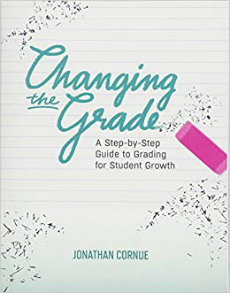A Guide to Grading for Student Growth
Changing the Grade: A Step-by-Step Guide to Grading for Student Growth
By Jonathan Cornue
(ASCD, 2018 – Learn more)

In Changing the Grade Jonathan Cornue details the reasoning for and process to transition from a traditional 100-point grading system to a standards-based grading approach.
While a teacher constantly focuses on what the next steps in instruction are and what the student is learning, an important part of a standards-based grading process is reporting out proficiency to the student, to the parent/guardians, and to the student’s future teacher.

Cornue details how to align assignments, assessments and report cards to the standards-based model and emphasizes the need for consistency in reporting out. He includes several examples of rubrics, assignments, assessments, and report cards to help guide the process.
If your school district/team is looking to transition to SBG, I would definitely consider this resource as a helpful guidebook. Cornue’s 30-step process will help you consider important checkpoints at each stage of the journey. Additionally, the commentary on how colleges and employers might respond to an alternative grading system is valuable to consider and discuss with staff members as you progress toward this end goal.
While this book was not as useful for me – my small-school structure does not lend itself to a team of people re-doing class assignments/assessments – it is still a valuable read. I was challenged to look at what my gradebook does report, what my students focus on, and what my parents/guardians currently know about their student’s progress in learning, and whether that knowledge is sufficient.
Julie Bernardi teaches sixth, seventh, and eighth grade math at a small community school in Central Oregon. Beyond math, she has taught ukuleles, Rubik’s Cubes, coding, art, ultimate frisbee, and more. She loves working with the same students for three years while they develop in so many ways…height, music tastes, mathematical thinking, and fashion.




























